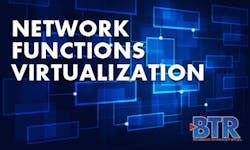The ramifications of the techniques are so deep and fundamental that MSOs are playing with fire if they are not already deep in research and development mode. “It is probably accurate to say that both SDN and NFV still are in their early stages,” said Tom Cloonan, ARRIS’ chief strategy officer. “They are under study and analysis inside operators, vendors and at CableLabs. They all are trying to figure out how it makes the most sense to use them.”
In short, SDN separates the data and control plans. In essence, that means the bits that determine where data is going are segregated from the payloads themselves. This allows management of the streams to be centralized and links to be far more flexibly and creatively set up. The nature of the data flows – for instance, the appropriate quality of service (QoS) threshold and level of security – can be fluidly changed in real time.
NFV takes advantages of the explosion of computer horsepower and software capabilities to replace purpose-built hardware platforms and favor of commodity servers running specialized software. Whether a server in the field acts, for instance, as a load balancer or a router is determined by software.
The two concepts are earth shattering, at least as far as network planning goes. The overused illustrative technique of comparing broadband to a physical highway once again is useful. In a traditional network, each car has a driver who is wedded to a specific route (representative in this example of the control plane). There is no flexibility. The driver delivers the payload (a passenger, a member of the data plane) to the destination. If there is a traffic jam or a drawbridge stuck in the up position, the packet will be late. The driver and the passenger are joined at the hip.
In an SDN environment, the driver leaves the car and moves to a virtual control tower, where unique directions are given to all the cars on the road simultaneously. Not only has the driver been promoted to a dispatcher, but the decisions made at that higher perspective can take into account ambient conditions: Is it wise to take a longer route that bypasses a bad traffic jam? Is a quick but treacherous one-lane highway appropriate for a car carrying a very valuable and sensitive passenger? In fact, shortcuts unavailable in the traditional environment could be found and temporary adjustments made to give certain roads attributes that they normally lack.
To take the analogy a bit further, NFV deals with the nature of the passenger. Once the data arrives at the commodity server, will the nature of that passenger turn the virtual device in a load balancer, a firewall, a security application, a CCAP or a platform serving another function?
Insiders say that SDNs are being tested by cable operators and will have real world impact before NFV. In a sense, however, a proto-NFV application already is available. Alon Bernstein, a distinguished engineer in the office of Cisco's (NASDAQ:CSCO) cable access business unit’s CTO, said that network DVRs - in which the service in the home is delivered from the network - fits the definition of NFV.
Though NFV and SDN are discrete advances, they are tending, at least to some extent, to blend into each other. “They tend to go together practically speaking,” Bernstein said. “Even though they address different needs, we see them as working together .... Probably the only way to manage [NFV virtualized servers] is with an SDN, anyhow.”
Parental control often is cited as an early virtualized service – and example of how NFV and SDNs can work together. NFV makes it possible to centralize in the network a set of rules that enable different levels of parental control for subscribers’ homes. However, the job at that point is only half done, since the virtual server would have to send marching orders to hundreds of thousands or even millions of CPE devices.
Adding SDN creates a scenario in which each set-top or gateway automatically queries the virtual server to ask if is okay for 11-year-old Jimmy and 5-year-old Susie to watch “Better Call Saul.”
Another early candidate for NFV treatment - one that is far more ambitious than parental control - is the converged cable access platform (CCAP). “The functions you will virtualize in a CCAP world include the functions of the cable control plane, IP MPLS, control and forwarding, subscriber management and video processing functions,” said Sachin Sathaye, the vice president of product strategy and marketing for ActiveVideo, a vendor of virtualized STBs.
Gainspeed, a company that is developing a virtualized CCAP, is a real-world illustration of how well the CCAP concept lends itself to NFV.
The cable industry is well-positioned in the NFV sector, according to observers. Cahit Akin, the CEO of Mushroom Networks, said the industry’s mentality is more in line with virtualized environments - both SDN and NFV - than the telephone companies. The telcos, he said, are accustomed to a one-to-one relationship between a network resource and a customer. Conversely, MSOs – who have built an empire on the shared resources inherent in the hybrid fiber/coax (HFC) approach – are more naturally open to virtualization. “From the get-go, cable operators have a different approach because they have the understanding of the management of a shared resource,” he said.
Mark Bieberich, the senior global marketing director at NetCracker Technology, suggests that there may be commercial developments of NFV in 12 to 18 months. “If anything, [cable operators] are slightly ahead of their telco brethren,” he said. “They are not as encumbered by legacy infrastructure, and the number of services they support are not as diverse. They tend to be more nimble.”





